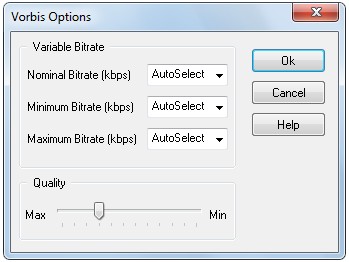Vorbis is a free software / open source project headed by the Xiph.Org Foundation (formerly Xiphophorus company). The project produces an audio format specification and software implementation (codec) for lossy audio compression. Vorbis is most commonly used in conjunction with the Ogg container format and it is therefore often referred to as Ogg Vorbis.
Vorbis had been shown to perform significantly better than many other lossy audio formats in the past in that it produced smaller files at equivalent or higher quality while retaining computational complexity comparable to other MDCT formats such as AAC or Windows Media Audio. However, there have not been many significant tests run in recent years.
Listening tests have attempted to find the best quality lossy audio codecs at certain bitrates. Some conclusions made by listening tests:
Low bitrate (less than 64 kbit/s): the most recent (2007) public multiformat test at 48 kbit/s showed that aoTuV Vorbis had a better quality than WMA and LC-AAC, the same quality as WMA Professional, and a lower quality than HE-AAC.
Mid to low bitrates (less than 128 kbit/s down to 64 kbit/s): private tests in 2005 at 80 kbit/s and 96 kbit/s showed that aoTuV Vorbis had a better quality than other lossy audio formats (LC-AAC, HE-AAC, MP3, MPC, WMA).
High bitrates (more than 128 kbit/s): most people do not hear significant differences. However, trained listeners can often hear significant differences between codecs at identical bitrates, and aoTuV Vorbis performed better than LC-AAC, MP3, and MPC.
When you click Options button Ogg Vorbis Options dialog shows.

Vorbis parameters
Vorbis' audio quality is not best measured in kilobits per second, but on a scale from --1 to 10 called "quality". This change in terminology was brought about by a tuning of the variable-bitrate algorithm that produces better sound quality for a given average bitrate, but which does not adhere as strictly to that average as a target.
This new scale of measurement is not tied to a quantifiable characteristic of the stream, like bitrate, so it's a fairly subjective metric, but provides a more stable basis of comparison to other codecs and is relatively future-proof.
For now, quality 0 is roughly equivalent to 64kbps average, 5 is roughly 160kbps, and 10 gives about 400kbps. Most people seeking very-near-CD-quality audio encode at a quality of 5 or, for lossless stereo coupling, 6. The default setting is quality 3, which at approximately 110kbps gives a smaller filesize and significantly better fidelity than .mp3 compression at 128kbps.
|
Quality |
Nominal Bitrate |
|
Q = -1 |
45 kbit/s |
|
Q = 0 |
64 kbit/s |
|
Q = 1 |
80 kbit/s |
|
Q = 2 |
96 kbit/s |
|
Q = 3 |
112 kbit/s |
|
Q = 4 |
128 kbit/s |
|
Q = 5 |
160 kbit/s |
|
Q = 6 |
192 kbit/s |
|
Q = 7 |
224 kbit/s |
|
Q = 8 |
256 kbit/s |
|
Q = 9 |
320 kbit/s |
|
Q = 10 |
500 kbit/s |
Vorbis is intended for sample rates from 8 kHz telephony to 192 kHz digital masters and a range of channel representations (monaural, polyphonic, stereo, quadraphonic, 5.1, ambisonic, or up to 255 discrete channels). Given 44.1 KHz standard CD audio sampling frequency) stereo input, the encoder will produce output from roughly 45 to 500 kbit/s (32 to 500 kbit/s for aoTuV tunings) depending on the specified quality setting. Quality setting goes from -0.1 to 1.0 for the Xiph library and -0.2 to 1.0 for aoTuV. Encoding front-ends map these values to an integer-based quality setting that goes from -1 to 10 for the Xiph library and -2 to 10 for aoTuV. Files encoded with a given quality setting should have the same quality of sound in all versions of the encoder, but newer versions should be able to achieve that quality with a lower bitrate. The bit rates mentioned above are only approximate; Vorbis is inherently variable-bitrate (VBR), so bitrate may vary considerably from sample to sample. (It is a free-form variable-bitrate codec and packets have no minimum size, maximum size, or fixed/expected size.)
|
Copyright (c) 2013 AudioDope team. All rights reserved.
|
|
What do you think about this topic? Send feedback!
|